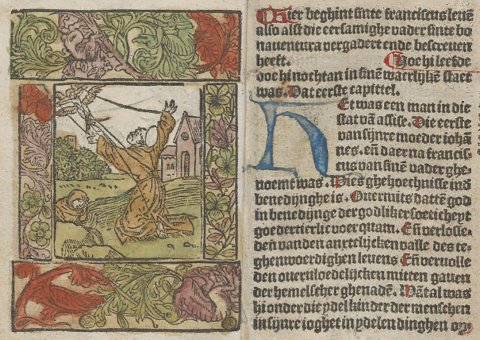'Die legende ende dat leven van sinte Franciscus'
Holy beggars
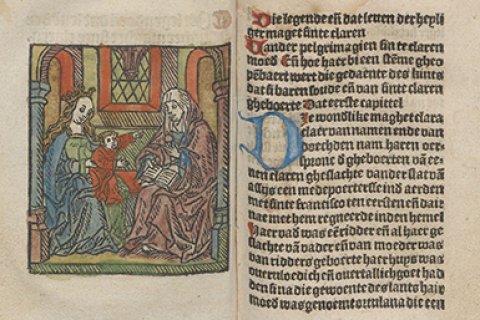
In 1205, the young Francis of Assisi decided to aid the poor and ill, live a life of poverty and preach the Gospel. He was the founder of the first mendicant order: the Franciscans, or the Order of Friars Minor. Around 1212, one of his followers, Clare of Assisi, founded the Poor Clares for female followers of Francis’ ideals. The Franciscans, Poor Clares and similar mendicant orders were very well received, and quickly spread throughout Christian Europe. It was not long before various biographies of the founders of the orders entered circulation, including biographies written in vernacular.
Rare books
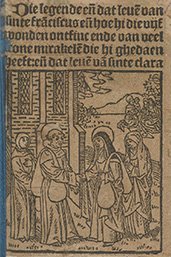
In Die legende ende dat leven van sinte Franciscus ende hoe hi die vijf wonden ontfinc ende van veel scone mirakelen die hi ghedaen heeft: ende dat leven van sinte Clara two Latin biographies are translated into Middle Dutch: firstly (fol. 1-195), a biography of Francis by Bonaventure, followed by a biography of Clare (fol. 196-244), which is attributed to Thomas of Celano, who was also the first biographer of Francis.
The Leiden-based printer Jan Seversz published this book in 1504. It was a simple and inexpensively printed work, and measuring only 9x13cm it was easy to carry around. There are only four known copies of this publication in Dutch libraries (Nijhoff-Kronenberg pp. xxviii and 171-2 §466): one in Amsterdam (Rijksmuseum Print Room. 325 E 1), one in Middelburg (Zeeuwse Bibliotheek) and two in Utrecht University Library. The copies in Utrecht University Library are from the libraries of the Franciscan monaseries in Weert (THO: RAR 2-81) and Megen (THO: RAR 4-70). The latter of these four is the only colour copy: rubrics have been included, initials have been added by hand in coloured ink and the woodcuts have been coloured.
A coloured copy
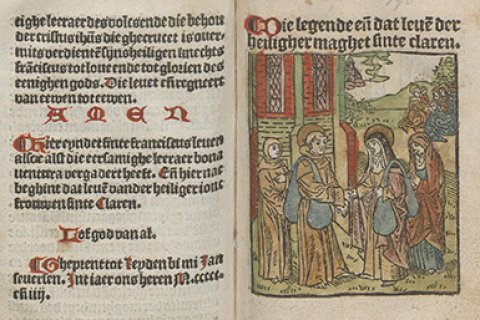
The woodcuts are the most striking feature of Die legende ende dat leven van sinte Franciscus... The colour copy (THO: RAR 4-70) includes a title page with an image of Francis being given stigmata – wounds corresponding to the wounds inflicted on Christ’s hands, feet and side on the cross – by a crucified winged angel.
The image is bordered at the top and bottom by plant and animal motifs. The animals look like dogs, but some of them are probably wolves, in reference to the story about Francis taming the wolf of Gubbio. Saint Francis is to this day the patron saint of animals, which is why World Animal Day is on 4 October: the feastday of Francis of Assisi.
The same images are included on the reverse of the title page, but the animals are upside down. A printed title is not included.
At the beginning of the biography of Clare (fol. 196) we do find a title. The image under the title Die legende ende dat leven der heiligher maghet sinte Claren ('The legend and the life of the holy virgin saint Clare') is, according to Gerard Pieter Freeman, unique. It depicts Francis and Clare, both of whom are begging, with a companion, when they meet each other. They are carrying their full beggar’s pouches over their shoulders. It is the only known depiction of Clare as a beggar. The same people are also pictured in the background, sitting in the field. Also in the background, God looks on from above. The reverse of this title page also includes another image, this time of Mary with the Christ Child on her lap, across from Mary’s mother Anne.
Black-and-white copy
The first title page of the black-and-white copy (THO: RAR 2-81) depicts Francis and Clare, and in this case the full title of the whole book is printed on a page smaller than the rest of the book. The image of Francis being given the stigmata is depicted on the reverse of the title page, bordered by the plant motifs and animals.
The front and reverse of the title page (fol. 197) of the biography of Clare is the same as in the coloured copy, but it is preceded by a page with images that are included in the colour copy as the title page of the work as whole (fol. 196).
A more beautiful misprint
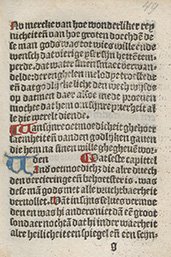
The coloured copy is actually a misprint. The title page to the work as a whole is missing and there are no signs that it was once included. The first page has on the front and reverse an image of Francis being given the stigmata, with the upside-down animals on the reverse. The mistake was probably first noticed in the first print, after a number of copies had already been printed and coloured. In the corrected print, the image of Francis and Clare that was included at the beginning of the biography of Clare is used, and a title for the book as a whole is included, printed on a page smaller than the rest of the book.
What about the page which on both sides depicts Francis who is given the stigmata? In the corrected print this is used as a closing image for the biography of Francis. The upside-down animals on the reverse are left upside down. Although the second print is an improvement as far as layout is concerned, it is not finished in the same way as the first print. It is not coloured and has neither rubrics nor initials, giving the impression of a significantly poorer quality.
It is possible that this inexpensively printed edition was intended for customers who could not afford a more beautifully finished copy. If this is the case, it is conceivable that most of the buyers of this book were members of the mendicant orders themselves. Their vow of poverty permitted them only to own the most simple and inexpensive of books. Perhaps they used it to read aloud sections in vernacular so as to spread the story of the deeds of Francis and Clare.
Author: Bart Jaski, 2011
